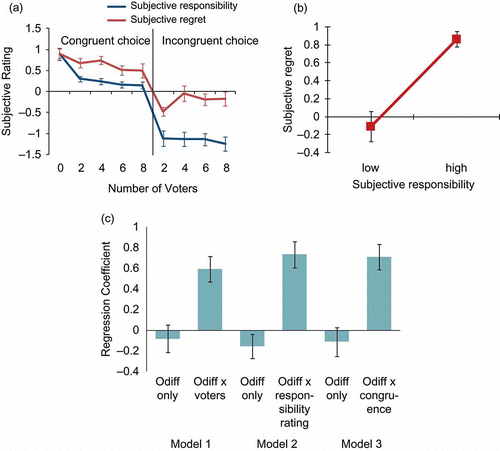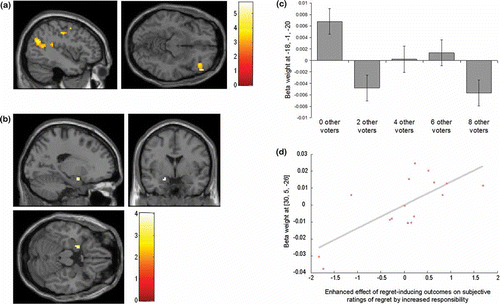Figures & data
TABLE 1 Details of the gamble pairs used in the task, including the probabilities of each of the winning and losing outcomes (in points) of each gamble option
Figure 1. An exemplar trial timeline. Trials included a choice phase in which participants select their choice of gamble, with choice indicated by a blue box. For each gamble, outcome probabilities were indicated by wedge size, with corresponding outcomes written above in number of points. Number of other voters was also shown, but was constant for mini-blocks of 5 trials. A gamble selection stage followed, in which the gamble receiving the highest number of votes was indicated with a yellow box. This gamble was then played, with its outcome affecting participants' winnings whether chosen by them or not. Next, the outcome of both the played and the unplayed gambles was revealed.

Figure 2. (a) Gradually decreasing mean normalized ratings of subjective responsibility and of subjective regret under congruent and incongruent choices with 0, 2, 4, 6, and 8 other voters, otherwise considered objective responsibility. For clarity, subjective regret ratings here are shown only for negatively discrepant outcomes, i.e., where the outcome of the played gamble was worse than the outcome of the unplayed gamble. (b) The mean normalized subjective ratings of regret, displayed as a binary separation of low and high subjective responsibility, for negatively discrepant outcomes. (c) The mean regression coefficients for the three regression models used, each indicating that the predictive value of outcome discrepancy (Odiff) on subjective ratings of regret is greatly enhanced by multiplying this Odiff by one of the three measures of responsibility (number of voters, subjective rating of responsibility, or choice congruence). Error bars show the standard error of the mean across participants.

Figure 3. Group SPM data, thresholded at p < .005 for display purposes, shown on a normalized canonical template brain. (a) Activity in angular gyrus (peak at −42, −64, 25) and lateral OFC (peak at 51, 38, −11) associated with the average effect of linearly increasing negative outcome discrepancy. (b) Enhanced activity in amygdala (peak −18, −1, −20) associated with increasingly negatively outcome discrepancy during full responsibility (0 other voters) compared to other congruent choice trials in the presence of other voters. Plotted in (c) are the beta weights showing the same amygdala response to increasingly negative outcome discrepancy under the different numbers of other voters. (d) Right amygdala activity (peak 30, 5, −26) showing greater enhancement of its response (FWE corrected) to more negatively discrepant outcomes by increased responsibility in participants who showed a greater enhancement of subjective regret for increasingly negative outcome discrepancy by increased responsibility (decreased number of voters). Coordinates are in MNI space. Error bars show standard error of the mean.
